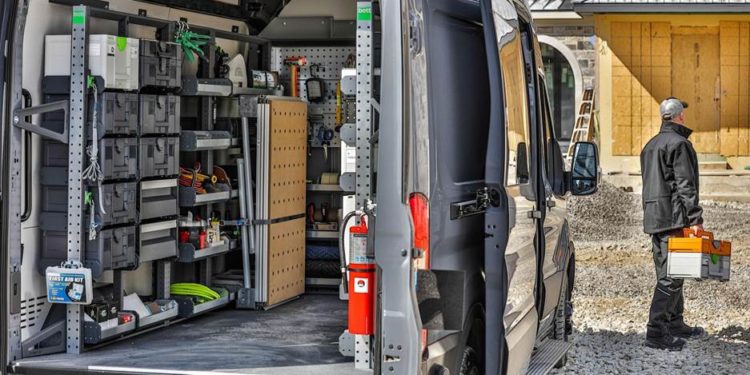Key Takeaways
Before diving into the details, here are the essential points about van shelving for contractors:
- Custom van shelving systems increase productivity by up to 30% through better organisation
- Plywood options offer DIY flexibility at lower costs (£200-500), while commercial systems (£800-2,000) provide durability
- Weight distribution is critical—improper loading can void warranties and create safety hazards
- Modular systems adapt as your business grows, protecting your long-term investment
- Professional installation takes 4-8 hours; DIY builds require 2-3 days for quality results
Ready to transform your work van? Explore our full range of van shelving solutions designed specifically for trade professionals.
Why Van Shelving Matters for Your Trade Business
As a contractor, your van isn’t just transportation—it’s your mobile workshop. The right van shelving system transforms chaos into efficiency, helping you locate tools faster, protect expensive equipment, and present a professional image to clients. I’ve watched countless tradespeople waste 15-20 minutes per job searching for the right fitting or tool in a disorganised van. That’s nearly two hours of billable time lost every single day.
Proper van organisation directly impacts your bottom line. When every tool has its designated place and you can access materials without unpacking half your van, you complete more jobs and reduce costly mistakes from bringing the wrong equipment.
Understanding Van Shelving Categories
Fixed Shelving Systems
Fixed van shelving provides the foundation for most professional setups. These permanently installed units bolt directly to your van’s interior framework, creating a stable platform that won’t shift during transit. Metal fixed systems typically use powder-coated steel or aluminium construction, offering excellent durability for heavy daily use.
The advantage of fixed shelving lies in its strength and reliability. You can safely store heavier power tools, paint buckets, and material stocks without worrying about collapse or movement. However, the permanent nature means less flexibility if you need to transport larger items occasionally.
Best suited for:
- Electricians requiring consistent tool access
- Plumbers with standardised pipe and fitting inventories
- HVAC technicians carrying diagnostic equipment
- Painters needing secure paint can storage
Modular Van Shelving Solutions
Modular systems revolutionise how contractors configure their workspace. These van shelving ideas feature interchangeable components—shelves, drawers, and bins—that attach to a rail or framework system. You can reconfigure layouts in minutes rather than hours, adapting to different projects or seasonal work requirements.
I once helped a multi-trade contractor switch from fixed to modular shelving. Within three months, he’d reconfigured his setup four times to accommodate varying job types, from kitchen installations to bathroom renovations. The flexibility prevented him from needing a second vehicle.
Key benefits include:
- Tool-free reconfiguration for changing needs
- Easy replacement of damaged components
- Scalable investment as your business expands
- Transfer capability between vehicles
Plywood Van Shelving Plans
DIY plywood van shelving remains popular among budget-conscious contractors and those wanting complete customisation. Quality 18mm marine-grade plywood costs roughly £50-70 per sheet, and a typical van conversion requires 3-4 sheets plus hardware, bringing total materials to £200-300.
The construction process demands careful planning. You’ll need to measure your van’s interior dimensions precisely, account for wheel arches and sliding doors, and ensure proper weight distribution. Marine-grade or exterior-grade plywood withstands moisture better than standard plywood, crucial for tools that might be damp or jobs in all weather conditions.
Construction considerations:
- Treat all exposed edges with waterproof sealant
- Use stainless steel fixings to prevent rust
- Install metal corner brackets for reinforcement
- Add edge banding for professional finish and splinter prevention
- Incorporate tie-down points for securing loose items
Many contractors enhance basic plywood van shelving plans with vinyl covering or rubberised coating for easier cleaning and improved durability. The DIY approach typically saves 60-70% compared to commercial systems, though installation takes 2-3 full days for quality results.
Material Comparison: Making the Right Choice
Steel Van Shelving
Steel systems dominate the commercial van shelving market for good reason. Powder-coated steel shelving handles extreme weight loads—typically 75-100kg per shelf—and withstands the daily punishment of tools being tossed in quickly between jobs. The coating resists scratches, chemicals, and corrosion, maintaining appearance and function for 10+ years.
The trade-off is weight. A complete steel system adds 80-120kg to your van, reducing payload capacity. For contractors frequently transporting heavy materials like tiles, plasterboard, or timber, this weight penalty matters. Modern high-strength steel designs use thinner gauge material to reduce weight while maintaining strength.
Aluminium Shelving Systems
Aluminium offers an attractive middle ground—approximately 40% lighter than steel while providing adequate strength for most contracting needs. Each shelf typically supports 40-60kg, sufficient for tool storage, parts bins, and moderate equipment. The weight savings translate directly to increased payload for materials.
Aluminium naturally resists corrosion, crucial for contractors working in coastal areas or harsh weather conditions. The material doesn’t require coating, though many manufacturers apply anodising for additional protection and aesthetics. The higher initial cost (roughly 20-30% more than steel) is offset by the fuel savings from reduced vehicle weight over the system’s lifetime.
Plywood and Composite Materials
Beyond traditional marine plywood, modern composite materials offer enhanced performance. Phenolic plywood uses resin-impregnated layers that provide exceptional moisture resistance and durability. Although more expensive (£90-120 per sheet), phenolic plywood outlasts standard marine-grade in demanding environments.
Composite polymer shelving is emerging as another option. These systems use high-density plastic materials that won’t rust, dent, or corrode. Weight sits between aluminium and plywood, while cost aligns with mid-range metal systems. The primary limitation is lower weight capacity—typically 30-40kg per shelf.
Van Shelving Configuration Strategies
Zone-Based Organisation
Professional contractors maximise efficiency through zone-based van shelving layouts. This strategy groups tools and materials by function or job type, reducing search time and ensuring you grab everything needed for specific tasks.
Effective zone categories:
- Hand tools zone: Frequently used items like screwdrivers, pliers, hammers in easy-reach locations
- Power tools zone: Secure storage with charging capabilities for cordless equipment
- Consumables zone: Screws, fixings, adhesives, and disposable items in labelled bins
- Safety equipment zone: Hi-vis, hard hats, first aid, and PPE near the door for quick access
- Specialty zone: Job-specific equipment that changes based on current projects
Place your most-used items between waist and shoulder height on the driver’s side for optimal access. Heavy materials belong on lower shelves near the van’s rear axle, maintaining proper weight distribution.
Drawer vs. Shelf Selection
The drawer versus shelf debate depends on your trade requirements and working style. Drawers excel for:
- Small parts and fixings that could roll or fall
- Expensive hand tools requiring protection
- Organised storage of electrical components
- Keeping items clean and dust-free
- Secure transport of fragile equipment
Open shelving works better for:
- Bulky power tools and equipment
- Paint cans, adhesive buckets, and chemical containers
- Longer items like spirit levels and pipes
- Quick visual inventory checks
- Items accessed multiple times per day
Most successful setups combine both approaches. Install drawers for valuable small items and precision tools, while using shelves for everyday equipment and consumables. Consider shallow drawers (100-150mm depth) for fixings and deep drawers (250-300mm) for power tool storage.
Installation Essentials and Safety Considerations
Professional Installation vs. DIY
Professional installation of commercial van shelving systems typically costs £200-400 in labour, with the work completed in 4-8 hours. Installers ensure proper anchoring to van chassis points, correct weight distribution, and compliance with manufacturer warranties. Many commercial systems require professional installation to maintain warranty coverage.
DIY installation of plywood van shelving plans demands different skills. You’ll need basic carpentry tools, a drill, jigsaw, and appropriate fixings. The most critical aspect is identifying and using proper mounting points—attaching only to van side panels causes shelving to tear away during sudden braking or collisions.
Safety mounting requirements:
- Locate and use factory-fitted tie-down points
- Bolt through to chassis rails or reinforced body sections
- Use spreader plates to distribute load across larger areas
- Install bulkhead protection if carrying heavy unsecured items
- Test installation by applying 2x the expected load before use
Weight Distribution and Legal Limits
Improper weight distribution affects vehicle handling, increases tire wear, and can invalidate insurance in accident situations. UK law requires commercial vehicles to stay within gross vehicle weight (GVW) and individual axle weight limits.
| Van Model | Typical GVW | Payload Capacity | Shelving Weight Impact |
| Small Van (Transit Connect) | 2,200kg | 600-750kg | 40-60kg shelving |
| Medium Van (Transit Custom) | 3,100kg | 1,000-1,300kg | 60-90kg shelving |
| Large Van (Transit) | 3,500kg | 1,200-1,500kg | 80-120kg shelving |
Calculate your typical tool and material load, add the shelving system weight, and ensure 10-15% buffer below maximum payload. Many contractors underestimate their actual working load, leading to overloaded vehicles that fail MOT inspections and create liability issues.
Weight distribution best practices:
- Position 60% of payload weight over or forward of rear axle
- Store heaviest items on lowest shelves
- Balance left-to-right weight distribution
- Secure all loose items with straps or bins
- Weigh your loaded van at least annually
Customisation Options That Add Value
Lighting Integration
Adequate lighting transforms van efficiency, especially for early morning starts or late-finish jobs. LED strip lighting draws minimal power (typically 5-10 watts per metre) while providing excellent illumination. Install strips under shelves to eliminate shadows and position them to illuminate work surfaces.
Motion-activated systems with battery backup prevent draining your van battery overnight. Many contractors report 20-30% faster tool location with proper lighting, particularly valuable during emergency call-outs.
Locking Systems and Security
Tool theft remains a persistent problem, with the UK seeing over 10,000 van break-ins monthly. Integrated locking systems for drawers and compartments add a crucial security layer beyond basic van locks.
Security enhancement options:
- Individual drawer locks for valuable tool storage
- Concealed compartments for expensive equipment
- Alarm-integrated locking mechanisms
- Tracking devices hidden within shelving structure
- Secure mounting for power tools using cable locks
Consider visible deterrents alongside hidden security. Thieves often move to easier targets when faced with obviously secure vehicles.
Specialised Holders and Accessories
Generic shelving benefits from trade-specific accessories that keep tools organised and protected. Explore our van storage accessories collection for options that enhance your setup:
Popular specialist additions:
- Drill holsters that grip power tools securely
- Pipe carriers for plumbers and gas engineers
- Ladder racks integrated with internal shelving
- Spill-proof containers for liquids and chemicals
- Magnetic tool strips for frequently-used items
- Adjustable dividers for varying stock sizes
These accessories typically cost £15-75 each but deliver immediate organisation benefits. The investment pays back through reduced tool damage and faster job preparation.
Maintenance and Long-Term Care
Quality van shelving requires minimal maintenance but benefits from regular attention. Inspect mounting bolts quarterly, tightening any that have loosened from vibration. Check for signs of stress or cracking around mounting points, particularly if you regularly carry maximum loads.
Clean shelving monthly to prevent dust and chemical buildup that can corrode protective coatings. Use appropriate cleaners—avoid harsh chemicals on powder-coated finishes, and treat any chips or scratches immediately to prevent rust development. For wooden systems, reapply sealant or protective coating annually to maintain weather resistance.
Quarterly maintenance checklist:
- Tighten all mounting hardware
- Check drawer slides for smooth operation
- Inspect for damage or stress cracks
- Clean and treat protective finishes
- Verify weight distribution hasn’t shifted
- Test locking mechanisms function correctly
Replace damaged components immediately rather than working around them. A failed shelf during transit can damage expensive equipment and create dangerous projectiles in accident situations.
Cost Analysis: Investment vs. Returns
Budget Breakdown by Approach
Understanding true costs helps contractors make informed decisions about van shelving investments:
DIY Plywood System (£250-500 total):
- Materials: £200-300
- Hardware and fixings: £50-100
- Protective coating: £30-50
- Labour: 16-24 hours of your time
Mid-Range Commercial System (£800-1,200):
- Shelving units: £600-900
- Installation: £200-300
- Accessories: £100-200
- Labour: 4-8 hours professional installation
Premium Modular System (£1,500-2,500):
- Base system: £1,200-1,800
- Customisation: £300-500
- Professional installation: £250-400
- Accessories and additions: £150-300
Return on Investment Calculations
Proper van organisation delivers measurable returns through time savings and reduced tool replacement costs. Consider a typical scenario:
An electrician saves 15 minutes daily through improved organisation—that’s 65 hours annually. At £50/hour billing rate, the time saving equals £3,250 in additional revenue potential. Factor in reduced tool damage from secure storage (typically £200-400 annually) and fuel savings from optimised weight (approximately £150-200), and even a premium system pays for itself within 6-12 months.
Browse our complete van shelving systems to find the solution matching your budget and requirements.
Trade-Specific Shelving Recommendations
Electricians
Electrical contractors benefit from drawer-heavy systems that protect sensitive testing equipment and organise the hundreds of small components typical in electrical work. Prioritise van shelving ideas that include:
- Shallow drawers with compartment inserts for terminals and connectors
- Protected storage for multimeters and testing devices
- Cable reel holders to prevent tangling
- Secure mounting for power tools and crimpers
- Labeled sections for different cable types and sizes
Plumbers
Plumbing work demands robust shelving that handles pipe sections, fittings, and heavy equipment like pipe threading machines. Effective van shelving for plumbers incorporates:
- Vertical pipe storage racks along van sides
- Heavy-duty lower shelves for copper coils and fitting boxes
- Spill-proof areas for flux and sealants
- Secure mounting for blow torches and gas bottles
- Easy-clean surfaces for managing wet conditions
Carpenters and Joiners
Carpentry requires accommodation for longer tools and varying material sizes. Successful configurations feature:
- Extended storage along roof areas for spirit levels and saws
- Adjustable shelf heights for different timber widths
- Protected compartments for precision measuring tools
- Drawer storage for chisels and hand tools
- Easy material loading access from rear doors
Frequently Asked Questions
How much weight can van shelving safely hold?
Weight capacity varies by material and installation quality. Steel shelving typically supports 75-100kg per shelf, aluminium handles 40-60kg, and plywood manages 30-50kg when properly braced. Always check manufacturer specifications and ensure total loaded weight stays within your van’s payload capacity. Distribute heavy items across multiple shelves rather than concentrating weight in one area.
Can I install van shelving myself or should I hire professionals?
DIY installation is feasible for those comfortable with basic construction work, particularly for plywood van shelving plans. However, commercial metal systems often require professional installation to maintain warranties and ensure proper anchoring to chassis points. Professional installation typically costs £200-400 and guarantees correct weight distribution and safety compliance. If you’re uncertain about locating proper mounting points or working with metal, professional installation is worth the investment.
What’s the difference between modular and fixed van shelving?
Fixed shelving is permanently installed in set configurations, offering maximum strength and stability but limited flexibility. Modular systems use interchangeable components that attach to rail frameworks, allowing reconfiguration without tools. Fixed shelving suits contractors with consistent tool requirements, while modular excels for multi-trade businesses or those with varying project needs. Modular systems typically cost 15-25% more initially but offer better long-term adaptability.
How do I prevent van shelving from rusting?
Choose powder-coated steel or aluminium systems for inherent corrosion resistance. For plywood installations, use marine-grade material and apply waterproof sealant to all edges and surfaces. Store wet tools in designated drying areas rather than directly on shelving. Inspect metal systems quarterly for coating damage and touch up chips immediately with matching paint. Ensure adequate ventilation to prevent moisture accumulation, and consider dehumidifiers for vans stored outdoors.
Will van shelving affect my vehicle warranty?
Most van manufacturers permit aftermarket shelving installation without voiding warranties, provided mounting uses approved anchor points and doesn’t involve cutting structural elements. Always check your specific warranty terms before installation. Professional installers familiar with your van model understand approved mounting locations. Keep documentation of professional installation work, as this demonstrates due diligence if warranty issues arise. Improper DIY installation that damages the van structure can void warranties.
What’s the best height for van shelving?
Optimal shelving height depends on your stature and the items stored, but general guidelines suggest placing frequently accessed tools between waist and shoulder height (approximately 75-150cm from floor). Lower shelves (30-75cm) suit heavy items and bulk storage, while upper shelves (150-180cm) accommodate lightweight, occasionally-used equipment. Avoid placing heavy items above shoulder height, as this creates injury risk and handling difficulty. Consider your tallest team member when planning upper shelf heights to ensure everyone can safely access stored items.
Conclusion: Transforming Your Mobile Workshop
Investing in proper van shelving transforms your vehicle from a chaotic storage space into an efficient mobile workshop. Whether you choose budget-friendly plywood solutions, mid-range commercial systems, or premium modular configurations, the key lies in matching the system to your specific trade requirements and working patterns.
Remember that the cheapest option isn’t always the most economical long-term choice. Consider durability, adaptability, and the time savings quality organisation delivers. A well-planned system that grows with your business provides better value than repeatedly replacing inadequate solutions.
Visit Van Shelves UK to explore our complete range of professional shelving systems, accessories, and trade-specific solutions designed by contractors, for contractors. Our team understands the daily challenges you face and can recommend configurations that maximise your van’s potential.











































































